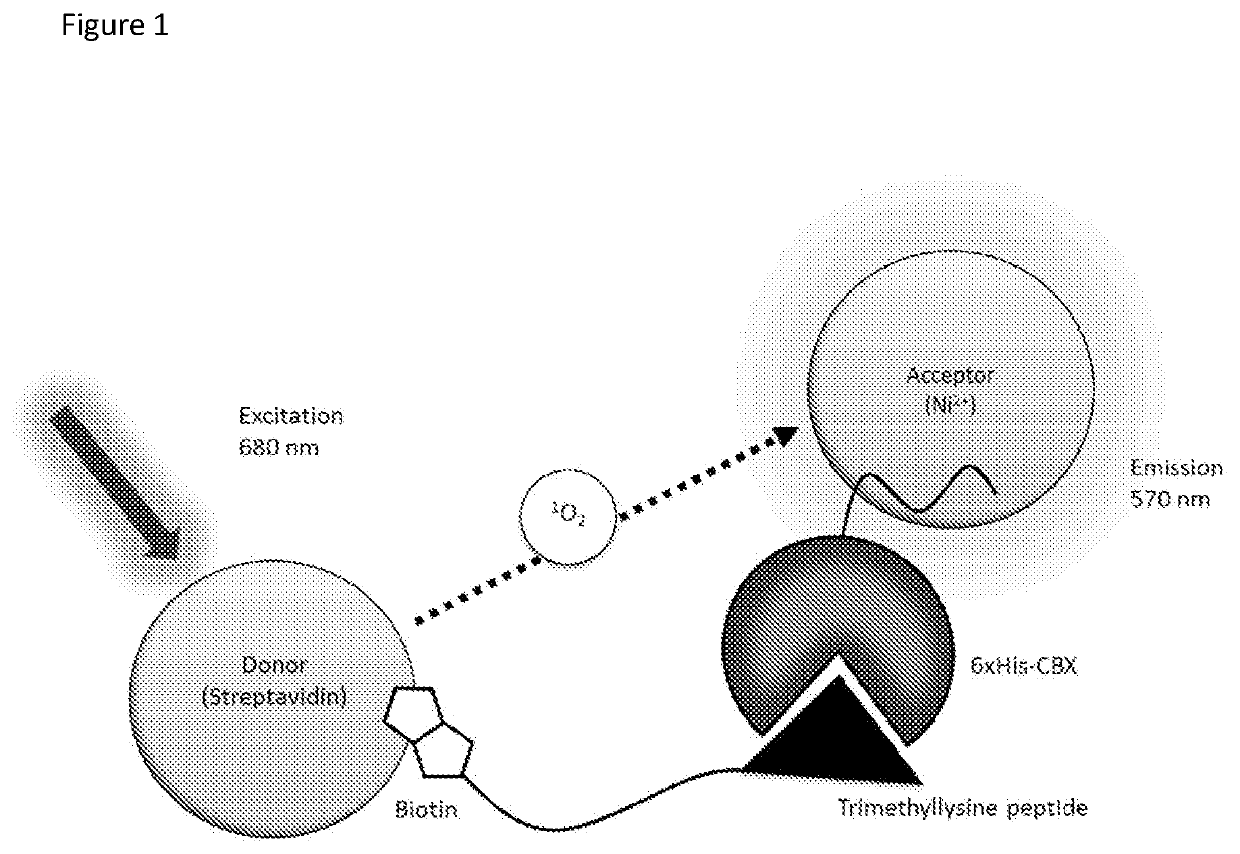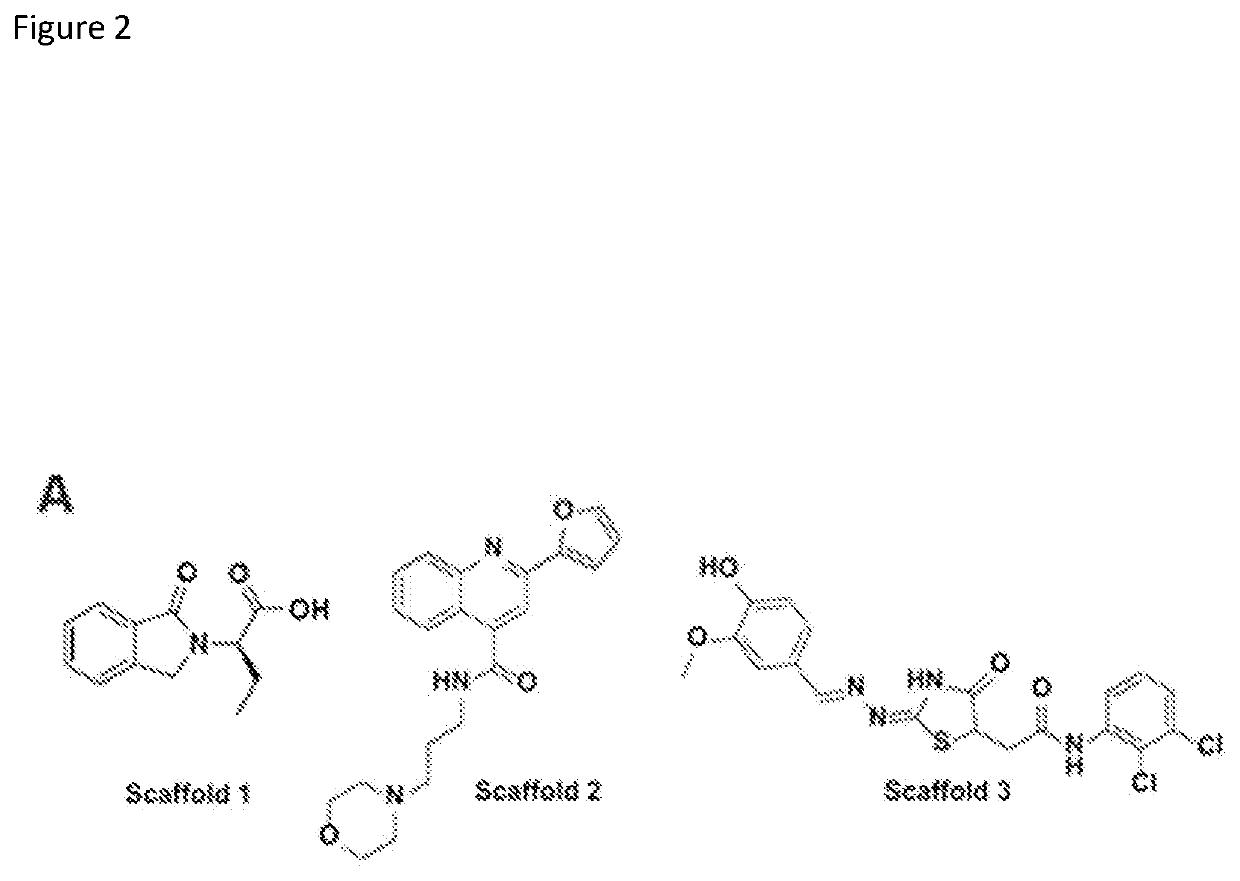Chromobox protein inhibitors and uses thereof
- Summary
- Abstract
- Description
- Claims
- Application Information
AI Technical Summary
Benefits of technology
Problems solved by technology
Method used
Image
Examples
example 1
Syntheses
[0185]A general procedure used in the methods to prepare various compounds of the invention are described below.
Synthesis of ACV-1-258C / ACV-2-195
(1) 2-(2,3,4-trihydroxybenzylidene)hydrazine-1-carbothioamide
[0186]2,3,4-trihydroxybenzaldehyde (338.3 mg, 2.20 mmol) and thiosemicarbazide (200.3 mg, 2.20 mmol) were combined and suspended in EtOH (4.4 mL) and a few drops of acetic acid were then added. The reaction was stirred at room temperature for 45 minutes. The reaction was then filtered and the precipitate was washed with hexanes to afford 1 as a white powder. MS: m / z (M+1)+: 228.24. 1H NMR (400 MHz, METHANOL-d4) δ ppm 6.42 (d, J=8.61 Hz, 1H) 6.88 (d, J=8.61 Hz, 1H) 8.13 (s, 1H).
(2) 1-(4-(pyrrolidin-1-yl)phenyl)-1H-pyrrole-2,5-dione
[0187]Maleic anhydride (121.0 mg, 1.23 mmol) was dissolved in CHCl3 (6.5 mL) and 4-(pyrrolidin-1-yl)aniline dihydrochloride (199.3 mg, 1.23 mmol) was then added. The reaction was stirred at room temperature for 3 hours. The reaction was filtered ...
example 2
[0213]A biochemical assay was developed based on nanoparticle AlphaScreen assay to monitor the binding of recombinant CBX chromodomain (CBX7) to a methylated peptide (H3K27me3).
[0214]The primary assay uses recombinant CBX chromodomain and synthetic, trimethylated H3 histone tail peptide. When CBX / histone tail-binding occurs, AlphaScreen beads are brought in close proximity, resulting in singlet molecular oxygen transfer and production of a luminescent signal. Assay positives inhibiting the binding interaction are therefore expected to prevent complex formation, diminishing signal intensity. The AlphaScreen technology features an anti-Stokes shift in detection: due to energy transfer between beads by singlet oxygen and internal chemical reactions within the acceptor bead, the emission wavelength is blue-shifted relative to the excitation wavelength, which is impossible in traditional fluorescent assays. The relatively long path length of 200 nm that singlet molecular oxygen can trave...
example 3
[0220]In order to further test and confirm the binding potency of the three ‘hit’ scaffolds to CBX, a collection of compounds was designed and synthesized for each scaffold to explore the structure-activity relationship (SAR). For Scaffold 1, a synthetic route was established to produce a variety of amides (Scheme 14). However, modification at the R position (highlighted) did not improve activity over the original compound. Further modification of the acid motif of Scaffold 1 also completely destroyed the compound's activity as assayed by the CBX AlphaScreen (FIG. 1). The narrow SAR around Scaffold 1 prompted the exploration of other scaffolds.
PUM
 Login to view more
Login to view more Abstract
Description
Claims
Application Information
 Login to view more
Login to view more - R&D Engineer
- R&D Manager
- IP Professional
- Industry Leading Data Capabilities
- Powerful AI technology
- Patent DNA Extraction
Browse by: Latest US Patents, China's latest patents, Technical Efficacy Thesaurus, Application Domain, Technology Topic.
© 2024 PatSnap. All rights reserved.Legal|Privacy policy|Modern Slavery Act Transparency Statement|Sitemap



